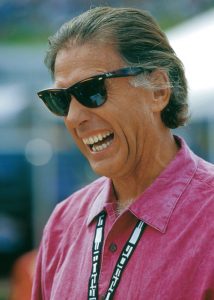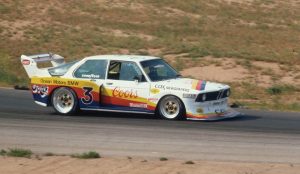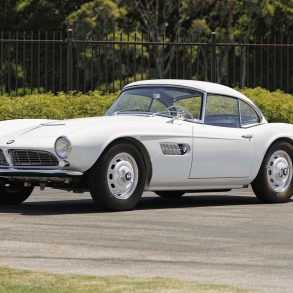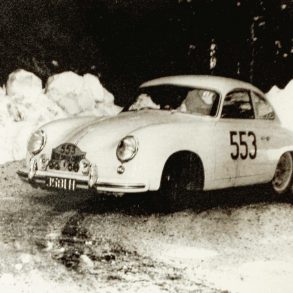When Peter Gregg did his deal to race BMWs in IMSA in 1976, he asked me to take over in the Brumos Porsche. At the end of the season, Peter decided he wanted to come back to Porsche to run the Trans-Am, and my Brumos deal went South. He hooked me up with Jo Hoppen who helped maintain my relationship with Porsche. Then Peter called and said, “BMW would like very much to support a car here in the U.S.” I said, “Where does that leave me?” He said he’d recommended that I be the guy. I said, “That’s really nice, what do I do?” He said, “You get on an airplane and you go meet Jochen Neerpasch in Munich.”
I didn’t have much going, and really wanted a deal as my shop was up and running and I had personnel and paychecks to write. I flew to Munich and met Neerpasch. What they wanted to do was give me all their factory cars, an enormous amount of stuff—two containers of engines and transmissions and two cars and bodies. Ronnie Peterson had been one of their drivers, and when he was killed at Monza they decided they’d curtail their European operation and hand it all to Busby Racing.

We brought the cars over here and redid the tube structure, moved the engines back, moved the driver back and built a full roll cage. BMW’s mechanical arm in this country was McLaren Engines in Detroit, and my operation was backed by Munich. Why that was, I have no idea. Tyler Alexander was running the McLaren operation, and Busby Racing was the surfers from Laguna Beach.
I read the rules and determined that an aerodynamic device on the back of the car could be anything as long as the rear window and the basic structure of the car remained intact. So I designed a fastback window that went over the original window, deck lid and everything else. It fed air to the wing and made an enormous difference. We also put splitters on the front to get even more downforce.
When we started testing at Riverside we were really quick. We show up at Road Atlanta and Tyler is asked by the press if he’d seen the rear window and wing on Busby’s 320. Tyler’s answer was: “That car will run in IMSA over my dead body.” So we ran the race, and the race report said: “We’re happy to report that Tyler Alexander remains in good health as of this writing.”
Next came the spring race at Laguna Seca. I made a good start and was running 2nd. We hurt an engine in qualifying, and McLaren gave us their spare. So I’m humping up the hill full tilt in top gear, with my hand on the shift lever and I feel this tremendous shudder and all of a sudden my hand gets pulled down through the shift boot, but I let go and pull my hand back up. The car is starting into a 360 just before the hump into the Corkscrew, and I start spinning over the hump and stop sideways in the track, facing downhill. Here comes (Danny) Ongais, and he’s in my oil, but he misses me. I’m thinking I’m OK, but here comes Carl Shafer in that 25,000-lb Camaro with the 454 in it. I’m thinking, “Oh shit, this is it!” I close my eyes and grit my teeth, but there’s no impact. Then I open my eyes and there’s this huge cloud of dust around this orange Camaro spinning down the inside of the Corkscrew. So cars keep coming at me on both sides, zoom, zoom, all sliding. Then it all stops and gets quiet.
Nobody has hit me, and I look down the track and the first thing I see is the driveshaft and transmission out of my car, about 100 yards down the road. Then I see the short block, with an oil pump hanging on the side of it, down further. It has blown the engine and the transmission out of the car! Bellhousing, clutch, flywheel, everything, and they’re all in pieces going down the track. All 14 quarts from the dry sump tank are on the track, the transmission oil’s on the track; it took them hours to clean the mess up.
I get out with my heart pumping away and walk over to the side of the track trying to check myself out and calm myself down. They towed the car down to the paddock, and dumped the engine and transmission on the ground next to it. My crew chief, Glenn Blakely, pulled the hood, which was one huge clip, off the car. I look in and see the cylinder head, the cam boxes, the turbocharger, the exhaust, injectors, the intercooler all there. There’s two small pieces of cast iron with the two motor mounts going down to the side of the chassis, and nothing else below the cylinder head! Everything’s gone. That was the first spectacular engine explosion I had.

Brainerd, Minnesota, three or four races later, qualifying, running really quick and it starts to sprinkle. I’m on slicks, thinking I need to see what it feels like in this sprinkle. Now I’m a drag racer, and I should have known better, but when you come onto the straight through that 90-degree right-hander, it runs through the staging area and the bleach box for the drag strip. Now bleach, which is what they were using at the time, and water, become pretty slippery. Stupid me, I didn’t relate to that. So I come flying around on slicks and when the front wheels hit it I knew I was in the shit because it started to push. Then the rear wheels hit it. I started doing 360s down the straight, and I’m thinking: “At least I’m spinning down the straight.” Except that the straight at Brainerd is crowned and has, for runoff, these concrete culverts. The first culvert is about 5 or 600 feet off the starting line, and as I slide off sideways my left side wheels hit the first culvert. The next thing I know it’s loud-quiet, loud-quiet, loud-quiet, and it lands on its wheels. So I get out and look around and the car is absolutely demolished. They haul the thing back and we decide we can rebuild it for the race.
So I get in the backup car—another 320, which had not run all season—and go right back out for the next session. It’s kind of a standard factory piece, but more a middle-of-the-packer than a front-rower. I notice the motor’s heating up a little bit and I come on the radio: “This one’s running a little hotter than the other car, we’ve only done two laps, what’s up?” They say, “Stay with it, it’s good.” Unbeknownst to me, the magnesium water pump casting had been sitting with liquid in it for three months in the truck and the vanes had rotted away. The water wasn’t circulating.
All of a sudden, one of the huge aluminum water pipes through the car goes Boom! It blows a fitting off and scalds me all along the upper side of my right leg and on my arm and hand. Of course, once that boiling water gets into your clothing, it just continues to cook you, so I jump out of the car and run around like a madman. So, we fix the other car and I start the race the next day with bandages all over me. I make a blinding start and I’m running 2nd to Gregg with Ongais behind me, and we come around the sweeper and the car gives a little bit of a vibration, and I’m thinking, “Did I run over something? What was that?” A millisecond later, the entire inside of the car is fire. Everything! I can’t see. The heat is absolutely beyond belief, and the engine is rattling, so I shove the clutch in really quick and close my eyes and hold my breath because that’s what you’re supposed to do in a fire. I’d never had a fire like that.
I decide I’ll ease off the track until I feel the dirt, then jump out. The heat is getting more and more intense and my legs and my butt are really beginning to hurt, and I’m still trying to find the edge of the road. The windows have been blown out, everything is just this huge ball of flames. I hear thump, thump, thump, thump and think, “OK, I’m off,” and I reach over to pull the leather strap that holds the door shut, and it’s gone. It’s been burned and I have no way of opening the door. I think: “At least let me get out of the seatbelts,” so I grab for the nylon tether that pulls the snap and it’s no longer there! I’m still holding my breath, and somehow I finally get my belts loose, but I can’t get the door open. I’m running out of time. I turn sideways in the seat and kick the door out and roll out on the grass. I don’t know why there’s no fire crew there. When I finally open my eyes and catch my breath I see my car burning to the ground. Then I realize I’m on fire because my suit’s soaked in oil and it’s on fire, so I start rolling around in the grass thinking, “I guess I’ve got it out, but I’ve got to get out of this suit.”

So I stand up. I’ve still got my helmet and my gloves on, and I pull my suit down around my ankles and realize that my underpants are on fire! So I’m slapping my ass, and I’m running around in circles with my suit around my ankles, helmet on, and there’s nobody coming. The fire triggered my mike button and blocked the track’s emergency communications system. So I pull my underpants down and my ass is steaming and my nuts got cooked too. I’m thinking, “This really hurts.” I look up, and I’m in front of a grandstand with maybe 1000 people in it. I hadn’t taken my helmet off and I wasn’t going to! So I laid down in this tall grass and waited for the emergency crew to come and haul me off to the hospital. The car burned right down to the ground and we never rebuilt it.
What happened was, when you want extra balancing mass in the crankshaft counterweight, you put heavy metal, Mallory Metal, in there. Well, that insert, a couple of inches long, had slid out of the crankshaft, sawed the block in half and dumped 14 quarts of oil on the turbocharger. Now, when they put Mallory Metal in a crankshaft, they don’t drill into the radial surface of the crank, they drill crossways through the counterweight so it’s captured, rather than being a slug. I managed to get out of the hospital the next day all bandaged up with salves and everything, and fortunately we had a break of several weeks before the next race, because I was burned up pretty good.
Ultimately, we got real frustrated with McLaren Engines because we lost 19 engines in eight races. Their car didn’t have much better reliability, but we had a fast car that wouldn’t finish. The cars handled beautifully, far superior to the Porsche. I still remember it as the most enjoyable GT car I ever drove.
As told to John Zimmermann










